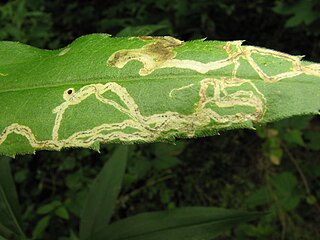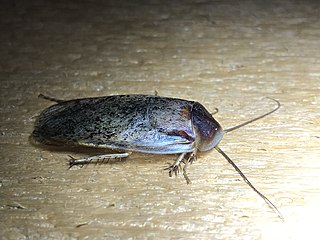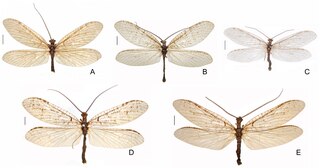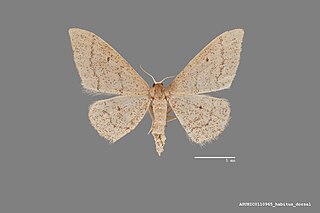
Insects in the family Tettigoniidae are commonly called katydids, or bush crickets. They have previously been known as "long-horned grasshoppers". More than 8,000 species are known. Part of the suborder Ensifera, the Tettigoniidae are the only extant (living) family in the superfamily Tettigonioidea.

The cicadas are a superfamily, the Cicadoidea, of insects in the order Hemiptera. They are in the suborder Auchenorrhyncha, along with smaller jumping bugs such as leafhoppers and froghoppers. The superfamily is divided into two families, the Tettigarctidae, with two species in Australia, and the Cicadidae, with more than 3,000 species described from around the world; many species remain undescribed.

Lymantria dispar, also known as the gypsy moth or the spongy moth, is an Eurasian species of moth in the family Erebidae. Lymantria dispar is subdivided into several subspecies, with subspecies such as L. d. dispar and L. d. japonica being clearly identifiable without ambiguity. Lymantria dispar has been introduced to several continents and is now found in Europe, Africa, Asia, North America and South America. The polyphagous larvae live on a variety of deciduous and coniferous trees and can cause severe damage in years of mass reproduction. Due to these features, Lymantria dispar is listed among the world's 100 worst invasive alien species.

Bingo Crosbyana is a 1936 Warner Bros. Merrie Melodies cartoon short directed by Friz Freleng, and notable for its title song, composed by Sanford Green and with lyrics by Irving Kahal. The short was released on May 30, 1936.

Phytomyza is a genus of leaf miner flies in the family Agromyzidae. At least 170 described species are placed in Phytomyza. The type species is Phytomyza flaveola, described by Carl Fallén in 1810.

Tettigoniidea is an infraorder of the order Orthoptera, with six extant families.
Bertkauia is a genus of insects in the family Epipsocidae. There are at least 2 described species in Bertkauia.
Noctuini is a tribe of owlet moths in the family Noctuidae. There are at least 520 described species in Noctuini.

Arenivaga bolliana, known generally as the Boll's sand cockroach or Boll's sandroach, is a species of cockroach in the family Corydiidae. It is found in North America.

Pisciforma is a suborder of mayflies in the order Ephemeroptera. There are at least 410 described species in Pisciforma.

Meropleon ambifusca, or Newman's brocade, is a species of cutworm or dart moth in the family Noctuidae. It was described by Newman in 1948 and is found in North America.

Campylomma verbasci, the mullein bug, is a species of plant bug in the family Miridae. It is found in Europe and Northern Asia and North America.

Trigonotylus pulcher is a species of plant bug in the family Miridae. It is found in Central America and North America.

Stenodemini is a tribe of plant bugs in the family Miridae. There are more than 60 described species in Stenodemini.

Peritropis saldaeformis is a species of plant bug in the family Miridae. It is found in North America.
Schistocerca ceratiola, the rosemary grasshopper, is a species of bird grasshopper in the family Acrididae. It is found in North America.

Neohermes is a genus of fishflies in the family Corydalidae. There are about 5 described species in Neohermes.
Capnobotes unodontus, the one-tooth longwing, is a species of shield-backed katydid in the family Tettigoniidae. It is found in North America.

Idaea productata is a species of geometrid moth in the family Geometridae. It was described by Alpheus Spring Packard in 1876 and is found in North America.

Limnichidae, commonly called minute marsh-loving beetles, is a family of beetles belonging to Byrrhoidea. There are at least 30 genera and 350 described species in Limnichidae. They are found worldwide, with the greatest diversity in tropical regions. Most species seem to be associated with water-adjacent habitats, such as riparian and coastal locations, though many species are likely fully terrestrial, with some species being associated with leaf litter and arboreal habitats. Species with known diets feed on moss or algae. The oldest fossils of the family are known from mid-Cretaceous Burmese amber from Myanmar.















